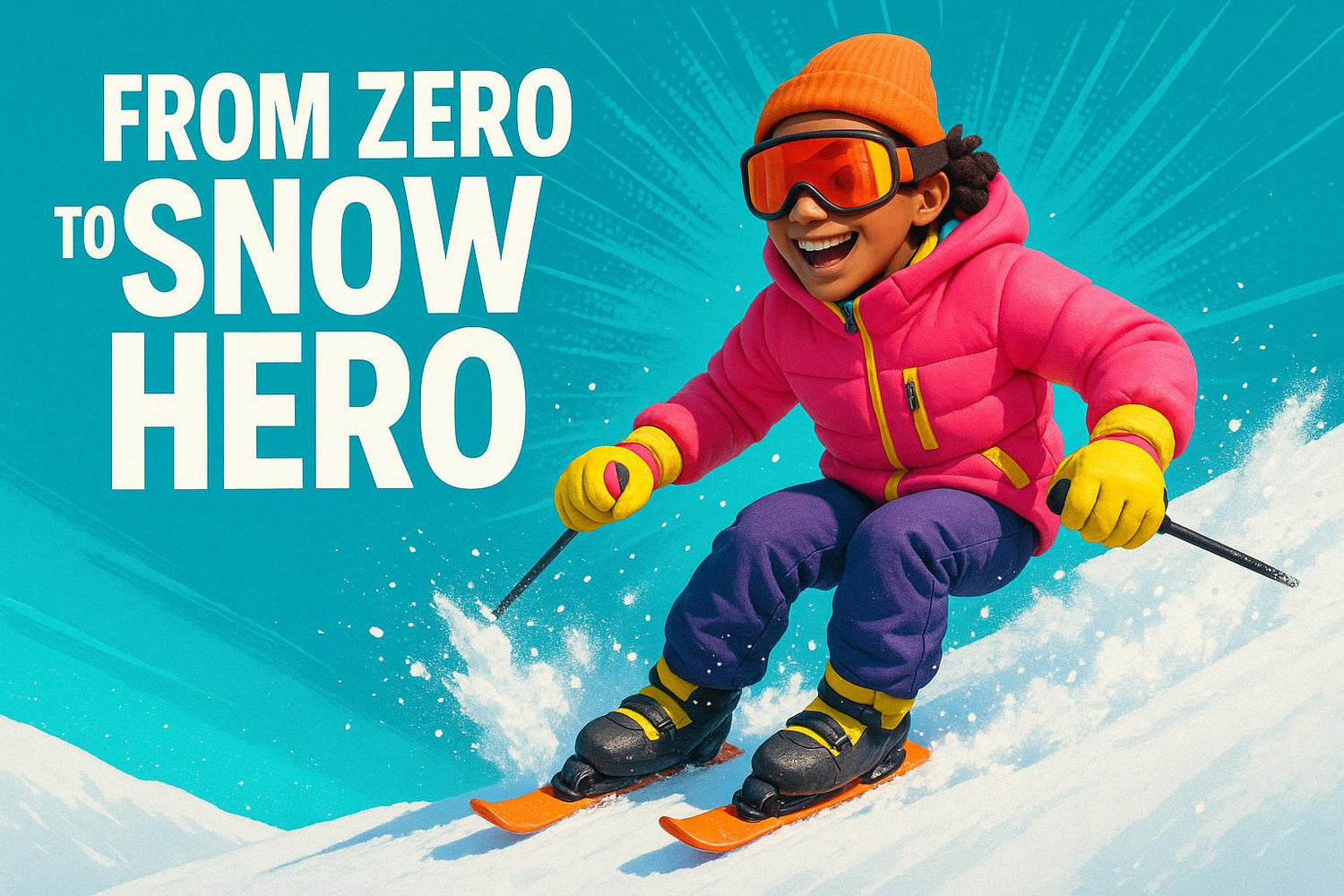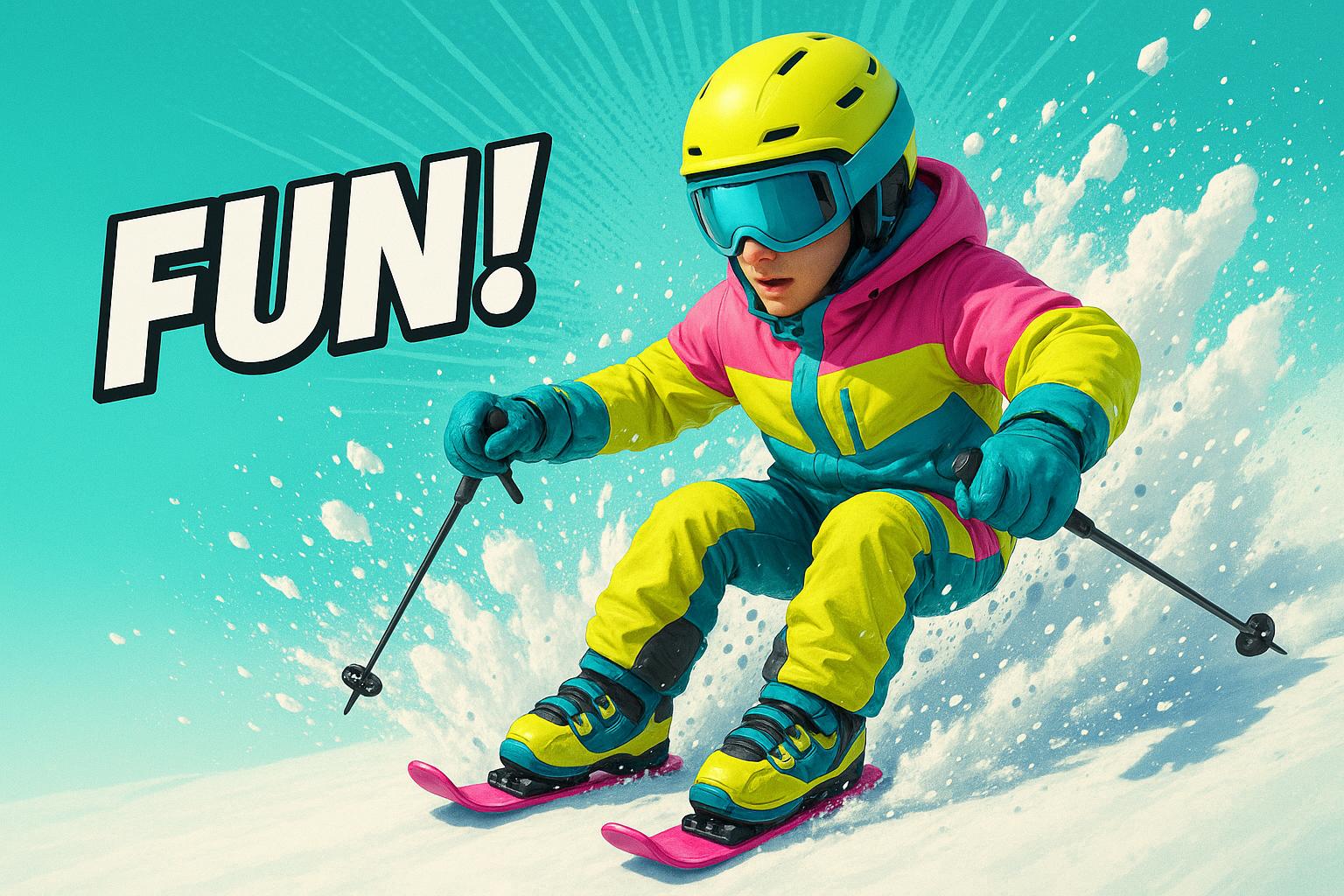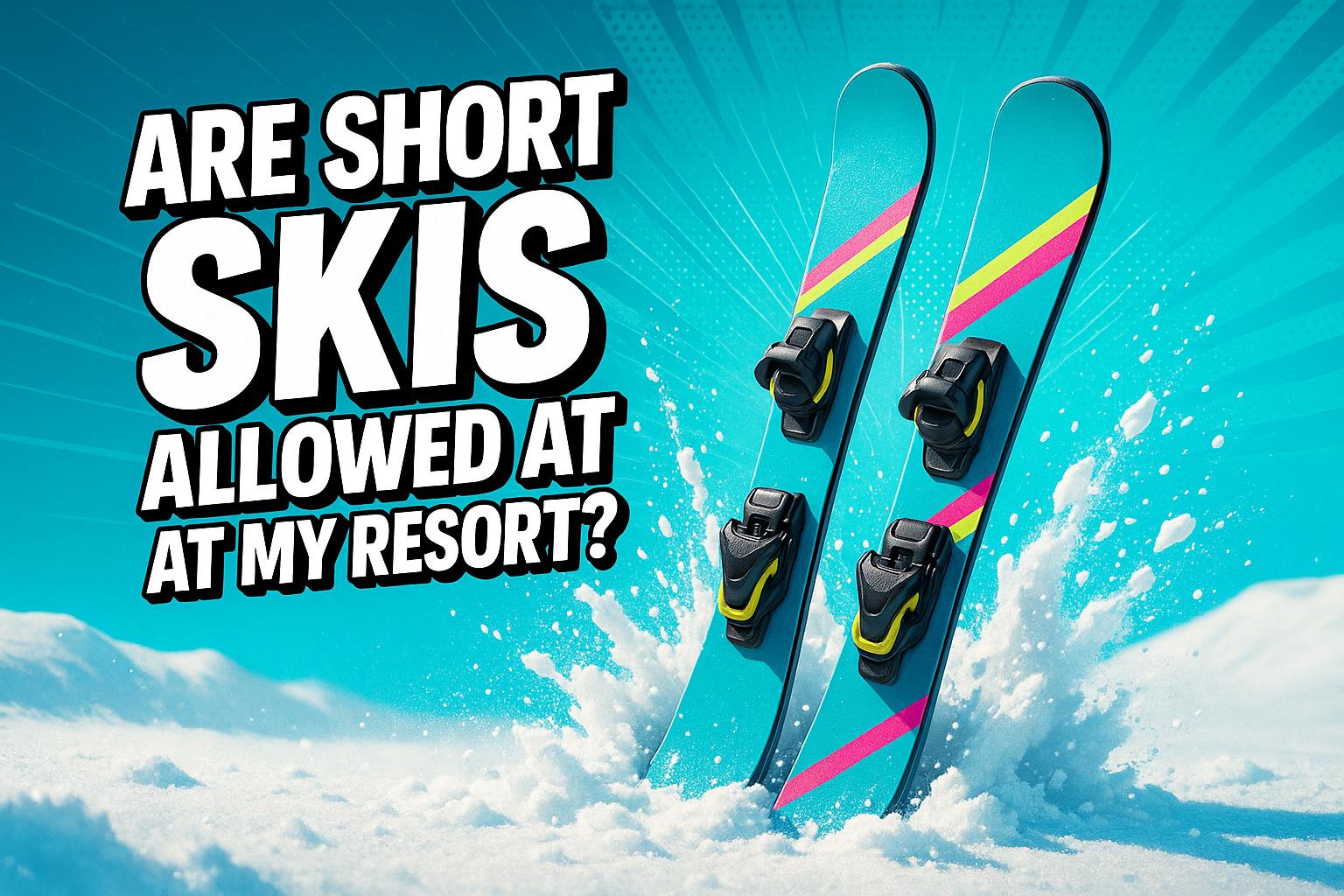従来のスキーの面倒なしでゲレンデを楽しみたいですか? SnowfeetのミニスキーとSkiskatesはコンパクトで手頃な価格、学びやすく、初心者から経験豊富なスキーヤーまで完璧です。人気が高まっている理由はこちらです:
- コンパクトで携帯しやすい:17インチから47インチまであり、バックパックに収まるのでかさばるギアは不要です。
- 初心者に優しい:たった1日で基本を習得でき、より良いコントロールと簡単なターンが可能です。
- 手頃な価格:価格は150ドルからで、従来のスキーセットアップよりずっと安価です。
- 通常のブーツで使用可能:高価なスキーブーツは不要です。冬用やスノーボードブーツを代わりに使えます。
- 多用途な地形対応:整備されたゲレンデ、地元の丘、公園、さらには裏庭でも最適です。
| 特徴 | Snowfeet ミニスキー&Skiskates | 伝統的なスキー |
|---|---|---|
| 長さ | 17〜47インチ | 150〜180 cm |
| 携帯性 | バックパックに収まる | かさばり、スキーラックが必要 |
| ブーツの互換性 | 通常の冬用ブーツ | 専用スキーブーツ |
| 価格帯 | $150〜$699 | $1,500以上 |
| 学習曲線 | 1日 | 数日/数週間 |
Snowfeetはスキーをよりシンプルに、安価に、そしてアクセスしやすくします。初心者でも、雪を楽しむ新しい方法を探している人でも、これらのショートスキーはゲームチェンジャーです。滑る準備はできましたか?さあ始めましょう!
Snowfeet* & Skiskates チュートリアル - プロのSkiskaterになる方法
なぜショートスキーがウィンタースポーツを変えているのか
ウィンタースポーツは変化の時を迎えており、そのすべてはショートスキーのおかげです。従来の装備はかさばり大きいことで知られていましたが、Snowfeetはコンパクトな代替品がゲームチェンジャーになりうることを示しています。これらの短い選択肢は高評価を受け、冬の装備に対する考え方を変えています。
数字を見てみましょう:Snowfeetの65cmスキブレードは126件のレビューで4.9の高評価を誇り、99cmモデルは96人の顧客から完璧な5.0のスコアを得ています。多くのウィンタースポーツファンがこの変化を受け入れ、従来の長いスキーはむしろ面倒だと感じているのが明らかです。
"ショートスキーは扱いやすく、コントロール性が高いため、初心者や中級者に最適な選択肢です。"
- Snowfeetチーム
持ち運びと収納が簡単
Snowfeetギアの最大の利点の一つは、その携帯性です。持ち運びが面倒なかさばる装備はもう忘れてください。SnowfeetのSkiskatesはわずか17インチで、最長のショートスキーでも47インチです。これにより、標準的なバックパックや車のトランクに簡単に収まります。大きすぎる装備に苦労することはもうありません!
誰でも簡単に学べる
もう一つの注目ポイントは、これらの製品がどれほど初心者に優しいかということです。短い長さのおかげでコントロールがしやすく、スキーの感覚をつかみやすくなっています。初心者にとっては、フラストレーションが減り、楽しさが増すということです。さらに、コンパクトなデザインが自然にバランスを取りやすくし、通常の学習曲線を短縮します。
そして、フットウェアについて話しましょう。従来のスキーは専用のブーツが必要で、面倒(しかも高価)なことが多いです。Snowfeet productsは、冬用ブーツ、スノーボードブーツ、スキーブーツなど、どんな靴でも使えるのが画期的です。アクセシビリティの大きな変化です。
さまざまな種類の雪で使える
Snowfeetは便利さだけでなく、驚くほど多用途でもあります。これらの短いスキーはあらゆる種類の雪の地形を楽々とこなします。圧雪されたPOWDERの上をクルージングする時も、地元の公園で新雪の中を滑る時も、あなたをしっかりサポートします。
例えばSkiskatesを見てみましょう。わずか17インチの長さで、スキーとスケートの動きを組み合わせており、伝統的なスキーでは苦戦する狭い場所や難しい地形をナビゲートするのに最適です。この柔軟性が冬の楽しみの新しい可能性を開きます。もうスキーリゾートに限定されることなく、地元の丘や公園、さらには裏庭でも雪の冒険を楽しめます。
| 地形タイプ | 伝統的なスキー | Snowfeet製品 |
|---|---|---|
| 整備された斜面 | 優秀 | 優秀 |
| POWDERの雪 | 良い(技術が必要) | 良い(操作が簡単) |
| 狭いスペース | 難しい | 簡単 |
| 地元の丘 | 非実用的 | 完璧 |
| 裏庭 | 不可能 | 理想的 |
17インチのSkiskatesから47インチのショートスキーまで、Snowfeetはあらゆる冬の冒険に対応する選択肢を提供します。トリックを決めるためにスノーパークに行くときも、急斜面をカービングするときも、このコンパクトなスキーは雪があなたを連れて行くどこへでも準備万端です。
Snowfeetの始め方:ギアとセットアップ
ショートスキーが冬のスポーツ界に新風を吹き込んでいる理由がわかったところで、ギア自体を見ていきましょう。製品オプションからアクセサリーまで、Snowfeetでスロープを楽しむために知っておくべきすべてです。
Snowfeet製品オプション
Snowfeetのラインナップは、さまざまなライディングスタイルやスキルレベルに対応するコンパクトで多用途なデザインが特徴です。主な製品の内訳は以下の通りです:
Snowfeetミニスキースケート
これらは最も小さく、予算に優しいオプションで、長さはわずか15インチです。150ドルからで、非常に軽量で冬用ブーツに直接クリップできるため、初心者に最適です。Basicモデルはプラスチック製で、PROバージョン(199ドル)はより良いビンディングとカラーバリエーションを備えています。
Skiskates
もう少し上級者向けのものを探しているなら、Skiskatesが選択肢かもしれません。価格は390ドルからで、伝統的なスキーに似た木製コアを持つ17インチのスキーで、スノーパークやスロープに最適です。ゲームをレベルアップしたいライダーにより多様性を提供します。
Skiblades
Skibladesは機敏さと安定性のバランスを取っています。短いバージョン(約26インチ)は450ドルからで、フリースタイルの動きや素早いターンに理想的です。長いもの(約39インチ)は490ドルで、カービングやオールマウンテンスキーに追加の安定性を提供します。POWDER愛好者には、深雪を巧みに扱う専用のPOWDERモデルがあります。
Snowfeetショートスキー
長さ47インチ、価格690ドルで、ラインナップ中最も長いオプションです。短いスキーの利点(扱いやすさなど)を求めつつ、高速時の安定性もあまり失いたくないスキーヤーに最適です。
"もし軽くて楽しく実用的なスロープ用のものを探しているなら、時間と神経を節約できるSnowfeetは素晴らしい選択です。" - Jakub F
予算や経験レベルに関係なく、Snowfeetは楽しく機能的で、ユーザーから高く評価されているギアを提供します。
ブーツのオプションとアクセサリー
Snowfeetギアの最もクールな点の一つは、ブーツとの柔軟性です。従来のスキーブランド(例えば、<a href="https://www.rossignol.com/" target="_blank" rel="nofollow noopener noreferrer">Rossignol</a>や<a href="https://www.atomic.com/en-us" target="_blank" rel="nofollow noopener noreferrer">Atomic</a>)のように高価で硬いプラスチック製スキーブーツを要求するのとは違い、Snowfeetはおそらくすでにお持ちのフットウェアで使えます。冬用ブーツ、スノーボードブーツ、さらにはスキーブーツでも対応可能です。
各製品には調整可能なビンディングが付属し、しっかりとしたフィット感を実現します:
- <strong>Basicモデル</strong>はより多くのプラスチック部品を使用しています。
- <strong>Xモデル</strong>は最も耐久性のあるビンディングを提供し、ほぼすべての靴に対応しています。
- <strong>IIモデル</strong>は中間的な選択肢で、テキスタイルで覆われたビンディングと便利なストラップポケットが特徴です。
そしてアクセサリーも忘れずに!これらの追加アイテムはギアを最高の状態に保ち、滑りを向上させます:
- ワックスキット:雪の付着を防ぎ、滑走速度を向上させます。
- セーフティリーシュ:特にトリックの練習や急斜面に挑む際に、ギアをしっかりと装着しておきます。
- 交換用ストラップ:長年にわたり装備を良好な状態に保ちます。
最高の結果を得るには、自宅でバインディングを調整し、スキーにワックスをかけてください。金属エッジを研ぐことも、氷結した地形での鋭いターンに役立ちます。
| ブーツタイプ | Mini Skis | Skiskates | Skiblades |
|---|---|---|---|
| 冬用ブーツ | ✓ | ✗ | ✗ |
| スノーボードブーツ | ✓ | ✓ | ✓ |
| スキーブーツ | ✗ | ✓ | ✓ |
| おすすめ用途 | カジュアル使用、初心者 | スノーパーク、トリック | オールマウンテン、カービング |
この柔軟性により、専用のスキーブーツを購入する手間(と費用)を省けます。手頃なMini Ski Skatesでも高級なSkibladesでも、既存の履物に対応し、あなたのスタイルに合わせて適応するギアを手に入れられます。
自信を持って滑るための基本テクニック
Snowfeetを装着して準備ができたら、基本をマスターする時です。これらのショートスキーは親しみやすく設計されており、HeadやElanのような従来のロングスキーに比べて、ゲレンデでの自信をつけやすくなっています。その寛容なデザインは、圧倒されることなく素早く学べる助けとなります。
バランスの取り方と正しい立ち方
スムーズな滑走の基礎は、正しいスタンスを取ることです。従来の硬いブーツで固定されるスキーセットアップとは異なり、Snowfeetは普通の冬用シューズで使えるため、より自然な姿勢が可能です。安定した土台を作るために、足は肩幅に開いてください。膝は軽く曲げておきましょう—内蔵されたショックアブソーバーのように働きます。さらに安定させるために、片足を少し前に出すと良いでしょう。このずらしたスタンスはSnowfeetの短い長さに合っており、より良いコントロールを実現します。
柔軟性が味方です。ふらつきを感じたら、腕を使ってバランスを取り戻しましょう。最初の数回は整備された斜面に限定し、急斜面やPOWDERの多い地形は慣れるまで避けてください。バランスが取れるようになったら、次は効果的な停止方法を学ぶことに集中しましょう。
停止とスピードコントロールの方法
スピードコントロールはSnowfeetのコンパクトなデザインが真価を発揮する部分です。短いスキーは停止をより速く直感的にします。まずはエッジを使いましょう—体重をエッジに移すことが減速の鍵です。初心者に優しい方法はクラシックなピザまたはスノープラウ技術です:Snowfeetの先端を互いに向け、内側のエッジを押し込んでくさび形を作ります。これで自然にスピードが落ちます。
完全に止まるには、ターン・トゥ・ストップ法を試してみてください。斜面を横切るようにターンし、エッジと体の位置を使って徐々に減速します。自信がついたらホッケーストップに進みましょう。これは斜面に対して直角に鋭くターンし、エッジに圧力をかけ、体をひねって素早く停止する方法です。Snowfeetチームの言葉を借りれば:
"停止はスキーでの停止に似ています。両方のスキーブレードで鋭く片側にターンします。"
どのテクニックを練習していても、バランスを崩さないように体重は中心に保ちましょう。緩やかな斜面から始め、特に混雑したトレイルでは常に注意を怠らないでください。停止が自然にできるようになったら、ターンとカービングに集中しましょう。
ターンとカービングの方法
Snowfeetでのターンは本当に楽しい瞬間の始まりです。短い長さのおかげで非常に操作しやすく、長いスキーでは得にくいコントロール性を提供します。ターンするには、行きたい方向の反対の脚に体重を移動させます。Snowfeetチームが説明するように:
"ターンしたいなら、反対の脚に体重をかけてください:右に曲がりたいなら左脚に、左に曲がりたいなら右脚に体重をかけます。"
より高度なターン技術であるカービングでは、ターンの方向に合わせた脚をリードにします。エッジの圧力を戦略的にかけましょう—リード脚の外側エッジとトレイル脚の内側エッジを押し込むことで、よりクリーンでコントロールされたターンが可能になります。
ヒントです:少しスピードを上げることで、実はカービングが上達します。増えた勢いがエッジを雪にしっかりと食い込ませるのに役立ちます。Snowfeetはスキーとスケートの動きを融合させることもでき、さまざまなコンディションや地形に対応する柔軟性を提供します。コンパクトなデザインのおかげで、従来のスキーよりもずっと早くこれらのテクニックをマスターできるでしょう。
スキルを磨く:初心者から上級者へ
Snowfeetは最初の滑りを魔法のように感じさせますが、本当の楽しみはスキルをレベルアップし始めたときに始まります。このコンパクトなショートスキーは、許容範囲が広く扱いやすいため、学習と上達に最適です。初心者から上級者へ、一歩ずつライディングを進化させる方法を見ていきましょう。
簡単なトレイルと緩やかな斜面から始めよう
自信をつける最良の方法は、初心者に優しい地形から始めることです。緩やかな6%から25%の勾配の緑の丸いトレイルが理想的で、圧倒されることなく練習する十分なスペースを提供します。
基本をしっかり押さえましょう—滑らかな体重移動と正確なエッジング。Snowfeetでの小さな調整が素早く目に見える結果をもたらします。各ターンの終わりにSnowfeetをわずかに上り斜面に向けることでターンを完璧にする時間を多く取りましょう。このテクニックは速度をコントロールするだけでなく、後でより急な斜面に挑戦する準備にもなります。コツを掴んだら、より難しい地形や異なる雪の条件で試してみてください。
より急な斜面とパウダーへ進もう
緩やかな斜面で快適に感じていますか?次のステップへ進みましょう!青い四角の斜面、そして最終的には黒いダイヤモンドのコースがあなたのスキルをさらに押し上げます。急斜面では、ターンは見た目だけでなく速度をコントロールする必要があります。ここでの重要な動きはサーフターンで、ターンの終わりに雪をしっかり掴んで早めに減速し、速度が増すのを防ぎます。
姿勢は攻撃的に、そして下り斜面に集中させましょう。SKIのMastering Steepsコースのインストラクター、Eric Liptonがこの重要なヒントを共有しています:
"急斜面でスキーヤーがよく犯す最も一般的なミスは、防御的すぎる滑り、つまり後ろに傾き、上側のスキーに体重をかけることです。体と目線は下り斜面に集中し、外側(下り側)のスキーに体重をかけてください。これははるかに攻撃的な姿勢です。急斜面は防御ではなく攻撃的に滑るスキーヤーに報います。"
急斜面での初めての滑りには、尾根を斜めに横切るスキーを試してみてください。これにより、急がずに最初のターンをセットアップするチャンスが得られます。Snowfeetの短い長さは方向転換を素早く行いやすく、急斜面での大きな利点となります。
そしてパウダーも忘れずに!Snowfeetの軽量設計は雪の上に浮かび続けることを可能にし、柔らかく深いコンディションでの使用が楽しくなります。Snowfeet POWDER (99 CM)モデルはまさにこれのために作られており、浮力とコントロールの絶妙なバランスを提供します。
よくある問題のトラブルシューティング
上級の地形に挑戦するとき、いくつかの問題に遭遇するかもしれません。対処法は次の通りです:
- つま先の引っかかり:Snowfeetの上に体を中心に保ち、上半身はリラックスさせましょう。過剰な腕の動きはバランスとコントロールを崩します。
- 氷結した状況:雪が硬く締まっているか氷結している場合はエッジに頼りましょう。カービングではなく少し滑るスキッドターンが最適です。エッジに一定の圧力をかけ、激しい動きを避けてください。
- バランスの維持:自然でバランスの取れた姿勢が最良の味方です。勢いを一定に保ち、エッジがしっかりグリップし、ターンが滑らかに保たれるようにしましょう。
Snowfeetはあなたの上達を助けるよう設計されています。その反応の良さと寛容なデザインにより、思ったより早く難しいコースに挑戦できるでしょう。段階を踏んで一つずつマスターし、ライドのすべての瞬間を楽しんでください。
sbb-itb-17ade95
ショートスキー vs 伝統的ギア:直接比較
Snowfeet*とRossignol、Atomic、Headなどの伝統的なスキー装備を選ぶと、その違いは明らかです。Snowfeet*は冬のスポーツに新しい視点をもたらし、伝統的なギアの常識を打ち破ります。
パフォーマンス:ターンとコントロール
Snowfeet*は38cmから120cmの長さで、伝統的なスキーの150~180cmと比べてコンパクトです。このサイズはより速いターンと狭い場所での優れたコントロールを可能にします。
ある満足したユーザーが完璧にまとめました:
「これらが大好きです。滑る感覚はローラーブレード、スノーボード、スキーのミックスのようです。」
– conrado、Amazon認証購入者
別のレビュアーは、どれだけ簡単に始められるかを評価しました:
「スノーボーダーでスキーヤーが踏み固めるのを見るのが嫌いな人にとって、学びやすく持ち運びも簡単です。」
– PANDORAMA、Amazon認証購入者
一部のユーザーは小さい表面積が深いPOWDERで扱いにくいと述べていますが、Snowfeet*の敏捷性とスキーとスケートのミックスという独特の感覚が際立った選択肢にしています。さらに、価格もずっと手頃です。
コスト:手頃な冬の楽しみ
伝統的なスキーギアは1,500ドル以上かかることがありますが、Snowfeet*は150ドルから699ドルの範囲です。例えば、彼らの最高級のショートスキーは約690ドルで、価格のごく一部で完全なセットアップを提供します。
それだけではありません。従来のスキー旅行は家族で2,500ドルから15,000ドルかかり、リフト券だけで一人あたり最大289ドルにもなります。従来のスキーの定期的なメンテナンス費用も加わり、費用は急増します。Snowfeet* はシンプルな設計でメンテナンス費用を抑え、冬のスポーツを手頃に楽しめるようにします。
便利さ:軽量で旅行に最適
Snowfeet* の最大の利点の一つは、その軽さと携帯性です。バックパックに簡単に収まり、従来のかさばるギアや専用ブーツが必要なセットアップとは異なり、普段の冬用ブーツで使えます。例えば Skiskates は約44cm、Snowfeet* はさらに短い38cmです。
この軽量設計は、外出先での冒険に最適です。人里離れた場所へのハイキングや冬の旅行のパッキングでも、Snowfeet* はシンプルで手間いらず。雪の冒険に新たな便利さを加えます。
Snowfeet ユーザーのための安全と準備のヒント
Snowfeet* に慣れてきたら、安全とメンテナンスに注目しましょう。これらのコンパクトなスキーは使いやすさを追求していますが、少しの準備が滑走をスムーズで安心なものにします。安全を保ち、ギアを最大限に活用するための重要なヒントを見ていきましょう。
適切な斜面の選び方
まずは整備された緑のコースから始めましょう—初心者に最適で、練習に寛容な環境を提供します。多くのスキーリゾートにはスキースクールが使う初心者向けの斜面があり、バランス、ターン、スピードコントロールの練習に十分なスペースがあります。基本に慣れるまではこれらの穏やかな斜面にとどまりましょう。
山の天気は予測が難しいので、重ね着で暖かく乾いた状態を保ちましょう。準備が整っていれば、ライドを楽しむことに集中できます。そしてついでに、安全に転ぶ方法を学ぶ時間を取りましょう—これは習得する価値のあるスキルです。
安全に転んで回復する方法
転ぶのは学習過程の一部なので、気にしすぎないでください。大切なのはリラックスして自然に転ぶことです。腕で体を支えようとすると手首や肩を痛めることがあるので避けましょう。
転んだときは、頭を守り滑りをコントロールするために足を下り斜面に向けるようにしましょう。急な斜面では、体を回転させ、肘や前腕を使って減速します。整備されたコースでは、体を硬直させずに少し滑りながらリラックスすることで衝撃を和らげます。可能なら、柔らかい雪で転ぶ練習をして慣れておくと良いでしょう。さらにボーナスとして、コンパクトなサイズの Snowfeet* は、かさばるギアを扱わずに簡単に立ち上がれます。
Snowfeet を良い状態に保つ方法
Snowfeet* のお手入れは簡単ですが、最高の状態を保つために重要です。まずはベースに定期的にワックスをかけて、スピードを向上させ、雪の付着を防ぎましょう。リキッドワックスは素晴らしい選択肢で、ボトルの指示に従うだけでOKです。
"Snowfeet*とSkiskatesをさらに速くし、雪がベースに付着するのを防ぐために、定期的なベースのワックスがけをお勧めします。" – Snowfeetチーム
エッジを忘れずに!エッジを鋭く保つことで、特に硬い雪上でのコントロールが向上します。自宅で便利なエッジチューナーを使うか、プロのスキーサービスショップでチューニングしてもらいましょう。最高の結果を得るためにベースエッジに特に注意を払ってください。
滑走後はエッジの水分を拭き取り、錆を防ぎましょう。長期保管の際は、エッジに薄くオイルを塗ってから収納してください。保管について言えば、バインディングがしっかり固定されているがリリース可能な状態であることを定期的に確認しましょう。シーズン終了後は、Snowfeet*を乾燥した場所に保管してください—コンパクトなサイズなのでクローゼットやガレージに簡単に収まります。
結論:あなたの雪のヒーローへの旅が待っています
あなたは今、初心者から自信に満ちた雪上の滑空者へと進化する準備ができています。Snowfeet*はRossignol、Atomic、Headのような従来のスキーブランドにはないものを提供します—軽量でコンパクト、そして信じられないほど使いやすいギアです。
従来のスキーは圧倒されることもありますが、Snowfeet*はシンプルで親しみやすいように設計されています。軽量でコンパクト、反応も良く、150ドルからの選択肢があります。整備されたコースを滑るのも、モーグルに挑戦するのも、テレインパークを楽しむのも、Snowfeet*はどんな挑戦にも楽々と適応します。
もう一つの大きな利点は携帯性です。かさばるスキーラックや大きなバッグに苦労する他の人たちとは違い、あなたはSnowfeet*をバックパックに放り込んで出かけられます。面倒もなく、手間もなし。この便利さは、短くて扱いやすく、初心者にも優しい設計と完璧にマッチします。
Snowfeet*はその多用途性で輝きます。整備されたゲレンデ、テレインパーク、さらには近所のそり遊びの丘でも素晴らしい働きをします。従来のスキーとは異なり、高価なリフト券や完璧なPOWDERの条件を必要とせずに冬のスポーツを楽しめます。自宅の裏庭、地元の丘、雪の公園、どんな場所でもSnowfeet*があなたの個人的な冬の遊び場に変えます。
さあ、ゲレンデが呼んでいます。Snowfeet*を装着して、あなたはその呼び声に応える準備ができています。雪のヒーローへの旅は最初の滑り出しから始まります—そして信じてください、その一滑り一滑りが忘れられないものになるでしょう。
よくある質問
Snowfeet製品は性能とコストの面で従来のスキーとどう比較されるのか?
なぜSnowfeet製品がゲームチェンジャーなのか
Snowfeet製品は、従来のスキーに代わる軽量で携帯性に優れ、手頃な価格の選択肢として注目を集めています。通常5フィート以上もある標準的なスキーの面倒な扱いを避け、Snowfeetは17インチから47インチまでのずっと短いデザインを提供します。この小さなサイズは扱いやすいだけでなく、膝への負担も軽減し、初心者が足場を見つけるのにも、経験豊富なスキーヤーが新しい感覚を求めるのにも、よりスムーズな滑りを実現します。さらに、そのコンパクトなサイズはかさばるギアを持ち運ぶ必要がなく、ただ手に取ってすぐに出かけられます!
コスト面で見ると、Snowfeetは本当に優れています。RossignolやAtomicのようなブランドのフルスキーセットは$600から$1,500かかることがあります。それに比べて、Snowfeetのモデルはわずか$150から始まります。冬のスポーツに挑戦したいけど予算を抑えたい人にはかなりお得です。そして心配しないでください - 価格のために楽しさや性能を犠牲にすることはありません!
POWDERや氷を含むあらゆる種類の雪の地形でSnowfeetを使えますか?
Snowfeetの製品、例えばスキーブレードやSkiskatesは、さまざまな雪の地形に挑むのに最適な選択肢です。整備された斜面、軽いPOWDER、さらには不整地のトレイルでも良好に機能します。これらの伝統的なスキーのコンパクトな代替品は使いやすく、冬のスポーツに遊び心をもたらします。ただし、その小さなサイズには限界もあります。深いPOWDERでは沈みがちで、氷の上では長いスキーほどのグリップはありません。
カジュアルスキーヤーや、手軽で高い操作性を求める人にはSnowfeetは確かな選択肢です。ただし、深いPOWDERや氷結した硬い斜面など、より厳しい地形に挑む上級者は、RossignolやAtomicのような伝統的なスキーを使い続けるのが良いでしょう。Snowfeetが本当に輝くのは、冬のスポーツを初心者やレクリエーションスキーヤーにとってよりアクセスしやすく、持ち運びやすく、そして純粋に楽しいものにする点です。
初心者が斜面でSnowfeetを安全かつ自信を持って使うためのベストなコツは?
Snowfeetの冒険を安全かつ自信を持って始めるために、いくつかの基本を押さえましょう。バランスが鍵です - 膝を軽く曲げ、足は肩幅くらいに開きます。この姿勢がコントロールを良くし、斜面で安定するのに役立ちます。次に、停止技術に慣れましょう。初心者は「スノープラウ」方式を試せます:スキーブレードを内側に傾けて減速または停止します。シンプルで効果的です。そして、良いウォームアップの重要性を忘れないでください。始める前に足首、膝、脚をストレッチすると、怪我のリスクを減らし、パフォーマンス向上に繋がります。
これらの基本をマスターすれば、Snowfeetの軽量で持ち運びやすいデザインを最大限に活かして、楽々と丘を滑り降りられます!


































コメントを残す
このサイトはhCaptchaによって保護されており、hCaptchaプライバシーポリシーおよび利用規約が適用されます。